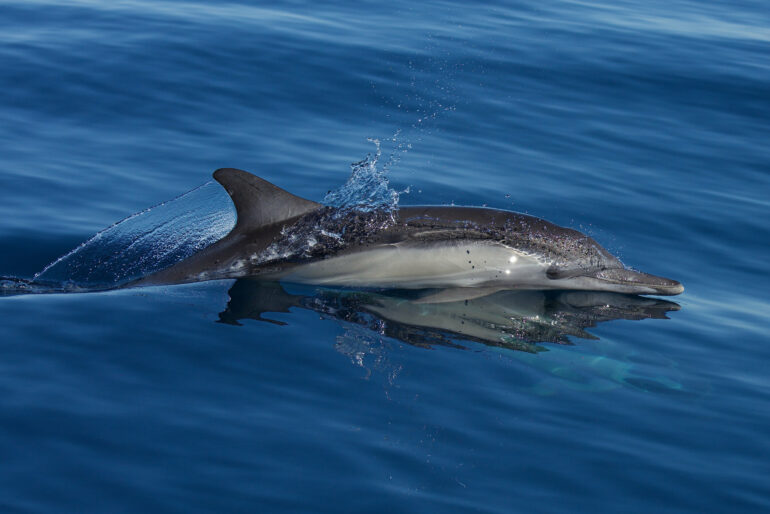For the first time ever, a team including several UC Santa Cruz scientists have directly measured the behavioral responses of some of the most common marine mammals to military sonar. And the finding that surprised them most was that these animals were sensitive to the sounds at much lower levels than previously predicted.
In a new study published on October 23 in the journal Royal Society Open Science, the international team sampled 34 dolphin groups, amounting to thousands of individuals, in experiments where simulated as well as operational military sonars were activated in carefully controlled conditions—or deliberately not played in experimental ‘”control'” conditions. The researchers then determined the types and likelihood of responses to known sonar exposures, which revealed unexpected behaviors.
“We see clear evidence of acoustic responses—fine-scale changes in movement including directed, sustained, strong avoidance, and changes in group configurations,” said lead author Brandon Southall, a UC Santa Cruz research associate and senior scientist at Southall Environmental Associates (SEA).
“While these behavioral changes occur and persist on variable time scales, they are surprising in that they collectively demonstrate responses at sound levels that are orders of magnitude lower than predicted in current regulatory impact assessments. These animals are clearly much more sensitive to noise exposure than we thought.”
For this study, the team used a novel integration of research methods combining aerial drone imagery, underwater listening recorders, and shore-based visual observers to monitor two social dolphin species. The merging of methodologies and tools presented a holistic view of how these social animals behave and respond to acoustic disturbances, according to co-author Ari Friedlaender, professor of ocean sciences at UC Santa Cruz.

Photo of short-beaked common dolphins taken using a drone at 200 feet. © John Durban/Holly Fearnbach
The researchers employed several substantial technological advances to measure these fast and playful species, for which fine-scale aspects of behavior had often been deemed too difficult to study. This included “drone photogrammetry,” the process of taking measurements from photographs collected non-invasively with drones.
John Durban, another senior scientist at SEA, noted that the firm has pioneered this process over the last decade to study whale and dolphin health. “In this study, we have been able to further develop this technique to geolocate dolphins with centimeter-level precision, enabling changes in behavior to be quantified in an objective way,” said Durban, also a co-author of the study.
Social dolphins, which can gather in groups of hundreds or even thousands, are common off the coast of California and many other regions, where they regularly encounter powerful military sonar systems known to disturb, harm, and even kill other species. Until now, there were no direct data on whether and how these sonars might affect these most abundant dolphins, despite regulatory assessments predicting that millions of animals might be impacted annually.
In recent years, mass strandings of cetaceans coinciding with the use of sonar systems by navies around the world have raised concerns that such noise exposure poses a potential threat to whales, dolphins, and porpoises. These incidents occurred when tactical sonars operated at “mid-frequency,” which typically ranges from 1 to 10 kHz. But in most cases, sonars operate in the 3–4 kHz band, the study states.
“Understanding how these animals respond to these types of acoustic signals is important for mitigating the impacts that this type of disturbance can have on social animals that rely on acoustics for communication, feeding, and other critical facets of their lives,” said study co-author Caroline Casey, a researcher at UC Santa Cruz.
Their study, “Behavioural responses of common dolphins to naval sonar,” also included contributions from the Hatfield Marine Science Center at Oregon State University, Cascadia Research Collective, Stanford University’s Hopkins Marine Station, SeaLife Response, Rehabilitation and Research, and in the Netherlands, Kelp Marine Research, and Royal Netherlands Institute for Sea Research.
More information:
Brandon L. Southall et al, Behavioural responses of common dolphins to naval sonar, Royal Society Open Science (2024). DOI: 10.1098/rsos.240650
Provided by
University of California – Santa Cruz
Citation:
Dolphins sense military sonar at much lower levels than regulators predict, study shows (2024, October 23)



